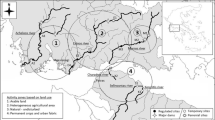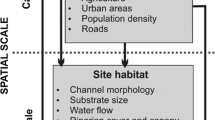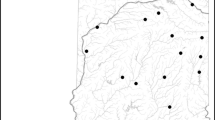Abstract
A total of 694 streams were sampled for benthic macroinvertebrates in the autumn of 1995 as part of the Swedish national stream survey. After removal of sites considered as impacted, data from 428 streams as well as a large number of environmental variables were used to determine the relative importance of local, landscape, and large scale factors in explaining the variability in species composition of benthic stream macroinvertebrates. The environmental variables were divided into seven explanatory variable groups: local physical, local chemical, catchment land use/cover, catchment bedrock geology, Quaternary geology in catchment, regional factors (such as ecoregion) and spatial position. Partial Canonical Correspondence Analysis was used to partition the total explained variance in the species data into these variable groups. The pure (or unique) effects of the seven variable groups accounted for 69.1%, and combinations of variable groups (interaction terms) the remaining 30.9% of the total explained variability. Local scale variables such as in-stream substratum, vegetation in and near the stream (riparian zone), and some chemical variables were most strongly associated with the among-site variability. Local physical (24.4%) and local chemical (20.4%) variables explained the largest part of the among-site variability of community assemblages. These results are of importance when planning conservation and management measurements, implementing large-scale biomonitoring programs, and predicting how human alterations will affect running water ecosystems.
Similar content being viewed by others
References
Allan J.D., Erickson D.L. and Fay J. 1997. The influence of catchment land use on stream integrity across multiple spatial scales. Freshwater Biology 37: 149–161.
Allan J.D. and Johnson L.B. 1997. Catchment-scale analysis of aquatic ecosystems. Freshwater Biology 37: 107–111.
Allen T.H.F. and Starr T.B. 1982. Hierarchy: perspectives for ecological complexity. Chicago of University Press, Chicago, Chicago, USA.
Borcard D., Legendre P and Drapeau P. 1992. Partialling out the spatial component of ecological variation. Ecology 73: 1045–1055.
Borcard D. and Legendre P. 1994. Environmental control and spatial structure in ecological communities: an example using orbatid mites (Acari, Oribatei). Environmental and Ecological Statistics 1: 37–61.
Carter J.L., Fend S.V. and Kennelly S.S. 1996. The relationships among three habitat scales and stream benthic invertebrate community structure. Freshwater Biology 35: 109–124.
Corkum L.D. 1989. Patterns of benthic invertebrate assemblages in rivers of northwestern North America. Freshwater Biology 21: 191–205.
European Committee for Standardization. 1994. Water quality-Methods for biological sampling-Guidance on handnet sampling of aquatic benthic macro-invertebrates. EN 27 828. European Committee for Standardization, Brussels, Belgium.
Fisher S.G. 1994. Pattern, process and scale in freshwater systems: some unifying thoughts.. In: Giller P. S., Hildrew A.G. and Raffaelli D.G. (eds.), Aquatic ecology: scale, pattern and process, 34th Symposium of the British Ecological Society with the American Society of Limnology and Oceanography, University College, Cork, 1992, pp. 575–606, Blackwell Scientific Publications, Oxford, UK.
Fredén C. 1994. Geology. Almqvist and Wiksell International, Stockholm, Stockholm, Sweden.
Frisell C.A., Liss W.L., Warren C.E.and Hurley M.D. 1986. A hierarchical framework for stream habitat classification: Viewing streams in a watershed context. Environmental Management 10: 199–214.
Hawkins C.P., Norris R.H., Gerritsen J., Hughes R.M., Jackson S.K., Johnson R.K. and Stevenson R.J. 2000. Evaluation of the use of landscape classifications for the prediction of freshwater biota: synthesis and recommendations. Journal of the North American Benthological Society 19: 541–556.
Heino J., Moutka T., Paavola R., Hämäläinen H. and Koskenniemi E. 2002. Correspondence between regional delineations and spatial patterns in macroinvertebrate assemblages of boreal headwater streams. Journal of the North American Benthological Society 21: 397–413.
Henriksen A., Kämäri J., Posch M. and Wilander A. 1992. Critical Loads of Acidity: Nordic Surface Waters. Ambio 21: 356–363.
Hill M.O. and Gauch H.G. 1980. Detrended correspondence analysis, an improved ordination technique. Vegetatio 42: 47–58.
Hynes H.B.N. 1975. The stream and its valley. Verhandlungen der internationale Vereinigung für theorische und angewandte Limnologie 19: 1–15.
Johnson L.B., Richards C., Host G.E. and Arthur J.W. 1997. Landscape influences on water chemistry in Midwestern stream ecosystems. Freshwater Biology 37: 193–207.
Johnson R.K., Goedkoop W. 2002. Littoral macroinvertebrate communities: spatial scale and ecological relationships. Freshwater Biology 47: 1840–1854.
Jongman R.H.G., ter Braak C.J.F. and Van Tongeren O.F.R. 1995. Data analysis in community and landscape ecology. Cambridge University Press, Pudoc, Wagening, The Netherlands.
Lammert M. and Allan J.D. 1999. Assessing biotic integrity of streams: Effects of scale in measuring the influence of land use/ cover and habitat structure on fish and macroinvertebrates. Environmental Management 23: 257–270.
Levin S.A. 1992. The problem of pattern and scale in ecology.Ecology 73: 1943–1967.
Liu Q. and Bråkenhielm S. 1995. A statistical approach to decompose ecological variation. Water, Air and Soil Pollution 85: 1587–1592.
Liu Q. 1997. Variation partitioning by partial redundancy analysis (RDA). Environmetrics 8: 75–85.
Malmqvist B. and Mäki M. 1994. Benthic macroinvertebrate assemblages in north swedish streams: environmental relationships. Ecography 17: 9–16.
Malmqvist B. and Hoffsten P-O. 2000. Macroinvertebrate taxonomic richness, community structure and nestedness in Swedish streams. Archiv für Hydrobiologie 150: 29–54.
Méot A., Legendre P. and Borcard D. 1998. Partialling out the spatial component of ecological variation: questions and propositions in the linear modeling framework. Environmental and Ecological Statistics 5: 1–27.
Minshall G.W. 1984. Aquatic insect-substratum relationships. In The Ecology of Aquatic Insects, pp. 358–400. Edited by Resh, V.H. and Rosenberg, D.M. Praeger Scientific, New York, New York, USA.
Minshall G.W. 1988. Stream ecosystem theory: A global perspective. Journal of the North American Benthological Society 7: 263–288.
Nordic Council of Ministers. 1984. Naturgeografisk regionindelning av Norden. Nordiska Ministerrådet, Oslo, Oslo, Norway.
Økland R.H. and Eilertsen O. 1994. Canonical correspondence analysis with variation partitioning: some comments and an application. Journal of Vegetation Science 5: 117–126.
Økland R.H. 1999. On the variation explained by ordination and constrained ordination axes. Journal of Vegetation Science 10: 131–136.
Ormerod S.J., Rundle S.D., Lloyd E.C. and Douglas A.A. 1993. The influence of riparian management on the habitat structure and macroinvertebrate communities of upland streams draining plantation forests. Journal of Applied Ecology 30: 13–24.
Poff N.L. 1997. Landscape filters and species traits: towards a mechanistic understanding and prediction in stream ecology. Journal of the North American Benthological Society 16: 391–409.
Richards C., Host G.E. and Arthur J.W. 1993. Identification of predominant environmental factors structuring stream macroinvertebrate communities within a large agricultural catchment. Freshwater Biology 29: 285–294.
Richards C., Johnson L.B. and Host G.E. 1996. Landscape-scale influences on stream habitats and biota. Canadian Journal of Fisheries and Aquatic Sciences 53: 295–311.
Richards C., Haro R.J., Johnson L.B. and Host G.E. 1997. Catchment and reach-scale properties as indicators of macroinvertebrate species traits. Freshwater Biology 37: 219–230.
Roth N.E., Allan J.D. and Erickson D.L. 1996. Landscape influences on stream biotic integrity assessed at multiple spatial scales. Landscape Ecology 11: 141–156.
Sandin L. and Johnson R.K. 2000. Ecoregions and benthic macroinvertebrate assemblages of Swedish streams. Journal of the North American Benthological Society 19: 462–474.
Sandin L. 2003. Benthic macroinvertebrates in Swedish streams: community structure, taxon richness, and environmental relations. Ecography 26: 269–282.
Statzner B. and Higler B. 1986. Stream hydraulics as a major determinant of benthic invertebrate zonation patterns. Freshwater Biology 16: 127–139.
Statzner B., Gore J.A. and Resh V.H. 1988. Hydraulic stream ecology: observed patterns and potential applications. Journal of the North American Benthological Society 7: 307–360.
ter Braak C.J.F. 1988. Partial canonical correspondence analysis. In Classification and Related Methods of Data Analysis. Proceedings of the First Conference on the International Federation of Classification Societies, pp. 551–558. Edited by: Bock, H.H. North Holland, Amsterdam, Amsterdam, the Netherlands.
ter Braak C.J.F. and Prentice I.C. 1988. A Theory of Gradient Analysis. In Advances in Ecological Research, pp. 272–317. Edited by Begon, M., Fitter, A.H., Ford, E.D. and MacFadyen, A. Academic Press, London, London, UK.
ter Braak C.J.F. 1990. Update notes: CANOCO version 3. 1. Agricultural Mathematics Group, Wagening, Wagening, the Netherlands.
ter Braak C.J.F. and milauer P. 1998. CANOCO Reference Manual and Users Guide to Canoco for Windows. Software for Canonical Community Ordination (version 4). Centre for Biometry, Wagening, Wagening, the Netherlands.
Tonn W.M. 1990. Climate change and fish communities: a conceptual framework. Transactions of the American Fisheries Society 119: 337–352.
Townsend C.R., Arbuckle C.J., Crowl T.A.and Scarsbrook M.R. 1997. The relationship between land use and physiochemistry, food resources and macroinvertebrate communities in tributaries of the Taieri River, New Zealand: a hierarchically scaled approach. Freshwater Biology 37: 177–191.
Wiberg-Larsen P., Brodersen K.P., Birkholm S., Grøn P.N and Skriver J. 2000. Species richness and assemblage structure of Trichoptera in Danish streams. Freshwater Biology 43: 633–647.
Wilander A., Johnson R.K., Goedkoop W. and Lundin L. 1998. Riksinventering 1995. En synoptisk studie av vattenkemi och bottenfauna i svenska sjöar och vattendrag. SNV Report 4813. Statens Naturvårdsverk, Stockholm, Sweden.
Wiley M.J., Kohler S.L. and Seelbach P.W. 1997. Reconciling landscape and local views of aquatic communities: lessons from Michigan trout streams. Freshwater Biology 37: 133–148.
Author information
Authors and Affiliations
Rights and permissions
About this article
Cite this article
Sandin, L., Johnson, R. Local, landscape and regional factors structuring benthic macroinvertebrate assemblages in Swedish streams. Landscape Ecol 19, 501–514 (2004). https://doi.org/10.1023/B:LAND.0000036116.44231.1c
Issue Date:
DOI: https://doi.org/10.1023/B:LAND.0000036116.44231.1c




